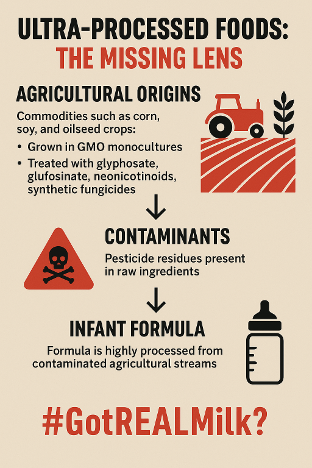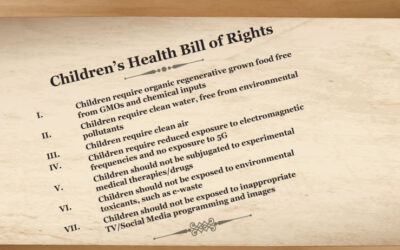Article 9 in the Got Real Milk Series
The new Lancet Series on ultra-processed foods (UPFs) does something important: it finally acknowledges that industrially engineered foods (those formulated from fractionated starches, synthetic additives, emulsifiers, and artificial flavors) are contributing to the global rise in chronic disease. But the series leaves out a crucial piece of the story, one that has direct implications for infants and young children: the agricultural origins of UPFs and the chemical residues they carry.
UPFs are not “born” on supermarket shelves. They originate in vast monocultures of genetically engineered corn, soy, and oilseed crops, grown with intensive applications of glyphosate, glufosinate, neonicotinoids, fungicides, and desiccants. These are not incidental details. These inputs determine the chemical content of the final product. Yet, the Lancet authors do not address how the UPF pipeline begins with GMO cropping systems and ends with measurable pesticide residues in the foods we feed our children.
This blind spot is especially troubling when we consider infant formula, one of the most ultra-processed products in the food system. Formulas rely heavily on GMO corn syrup solids, GMO soy proteins, and vegetable oils extracted from glyphosate-dependent and laden crops. These ingredients are then subjected to multiple layers of processing such as spray-drying, sterilization, and enzymatic modification before being combined with synthetic vitamins that are also derived from GMOs and their associated pesticides.
In GMOScience’s Got REAL Milk? series, we have shown repeatedly that infant formula contamination is not accidental. It is a predictable outcome of a supply chain built on industrial agriculture and chemical inputs. Recent findings of aluminum, arsenic, cadmium, lead, mercury, pesticides, and now even the overgrowth of Clostridia species in some formula batches all point to the same systemic problem: we are attempting to manufacture infant nutrition from agricultural streams contaminated at the source.
By omitting GMOs and pesticide load from the UPF conversation, the Lancet Series unintentionally reinforces a dangerous misconception which is the health risks of UPFs begin only at the processing stage. In truth, the risks begin in the soil, where GMO cropping systems and intensive chemical use shape the biochemical terrain long before a product reaches a processing plant.

For infants, the most vulnerable among us, this omission is not academic. It is a public health failure. If we truly want to protect children, we must broaden the UPF framework to include agricultural toxicology, contamination pathways, and the unique vulnerabilities of infants consuming ultra-processed formula as their sole source of nutrition.
This is the conversation missing from the Lancet.
And it is precisely the conversation we will continue advancing at GMOScience.



